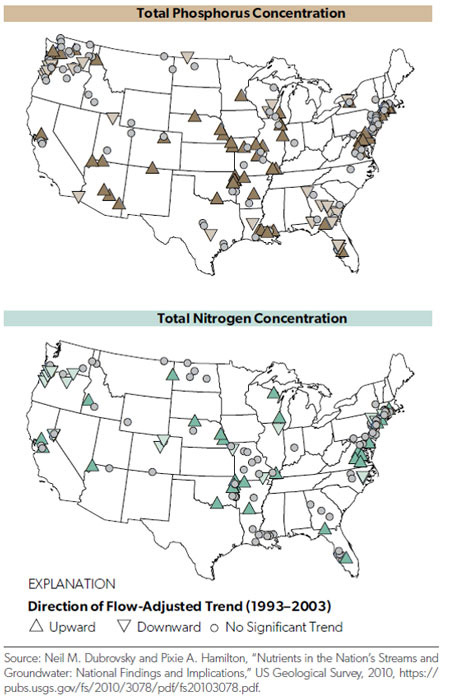Excerpted from the Environmental Impact of Missouri Crop Production report
- Fertilizer efficiency is increasing as farmers produce more units of crops per unit of fertilizer.
- Farmer-documented adoption of improved nutrient management practices is low, but it is likely increasing.
- The amount of nitrogen fertilizer applied in excess of crop removal has been steady over time, and the quantity found in Missouri rivers has been fairly constant over time.
- The amount of phosphorus fertilizer applied in excess of crop removal has been decreasing over time, but the quantity found in Missouri rivers has been trending up over time.
Fertilizers are essential for sustainable crop production, and worldwide, nearly 40% of the protein consumed by humans is derived from food which had synthetic nitrogen fertilizers applied.
Adoption of improved management practices
The 4Rs philosophy encourages farmers to apply nutrients of the right source at the right rate, right time and right place. It promotes practices associated with increased nutrient stewardship and efficiency, including incorporating a nitrogen stabilizer, using grid soil sampling, implementing variable-rate technology, splitting nitrogen applications, testing plant tissue, operating equipment with GPS guidance and adopting satellite imaging.
The table below highlights Missouri adoption of several 4R practices between 2003 and 2010 based on data from recent USDA Agricultural Resource Management Surveys.
| Practice | Corn, 2010 |
Cotton, 2007 |
Rice, 2006 |
Sorghum, 2003 |
Soybeans, 2006 |
Winter wheat, 2009 |
|---|---|---|---|---|---|---|
| Nitrification inhibitor | 12% | 22% | 39% | 5% | NA | NA |
| Plant tissue test | NA | 9% | 5% | NA | NA | NA |
| VRT for fertilizing | NA | 2% | NA | NA | 3% | 7% |
| Guidance or auto-steering system | 35% | NA | NA | 12% | NA | NA |
| NA: Estimate does not comply with NASS disclosure practices, is not available or is not applicable. Source: USDA Agricultural Resource Management Survey (2017) |
||||||
Impacts of nutrients on water quality
Farmers seek to keep applied fertilizers on the fields so the nutrients are available for crop production. As more applied fertilizers are taken up by crops, less is available to move from the land into the water or air. Fertilizer which is applied to cropland and subsequently enters water can cause various negative impacts. Most generally, fertilizer in water can cause excessive plant and algal growth, called eutrophication. This may result in dissolved oxygen depletion affecting aquatic life, and in the most extreme cases, it may lead to the release of compounds toxic to animals.
Crop nutrients, particularly nitrogen and phosphorus, which leave the field and enter waters may eventually flow into the Mississippi River and enter the Gulf of Mexico. The increase in nutrients in the Gulf of Mexico has created a “dead zone” caused by low oxygen conditions, called hypoxia.
The U.S. Geological Survey monitors water flow and nutrient concentrations within the Mississippi River Basin. The image below shows the direction of the flow-adjusted trend of nitrogen and phosphorus at various locations in the U.S. between 1993 and 2003. Phosphorus concentration in Missouri rivers trended upward or remained constant from 1993 to 2003. On the other hand, nitrogen concentrations in Missouri rivers held constant or trended downward from 1993 to 2003.
Measured phosphorus and nitrogen concentrations in U.S. waters
